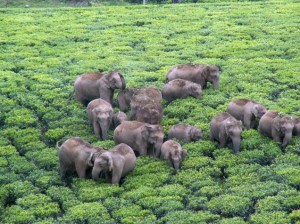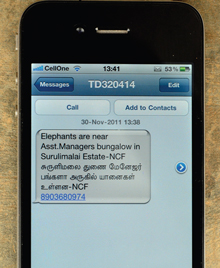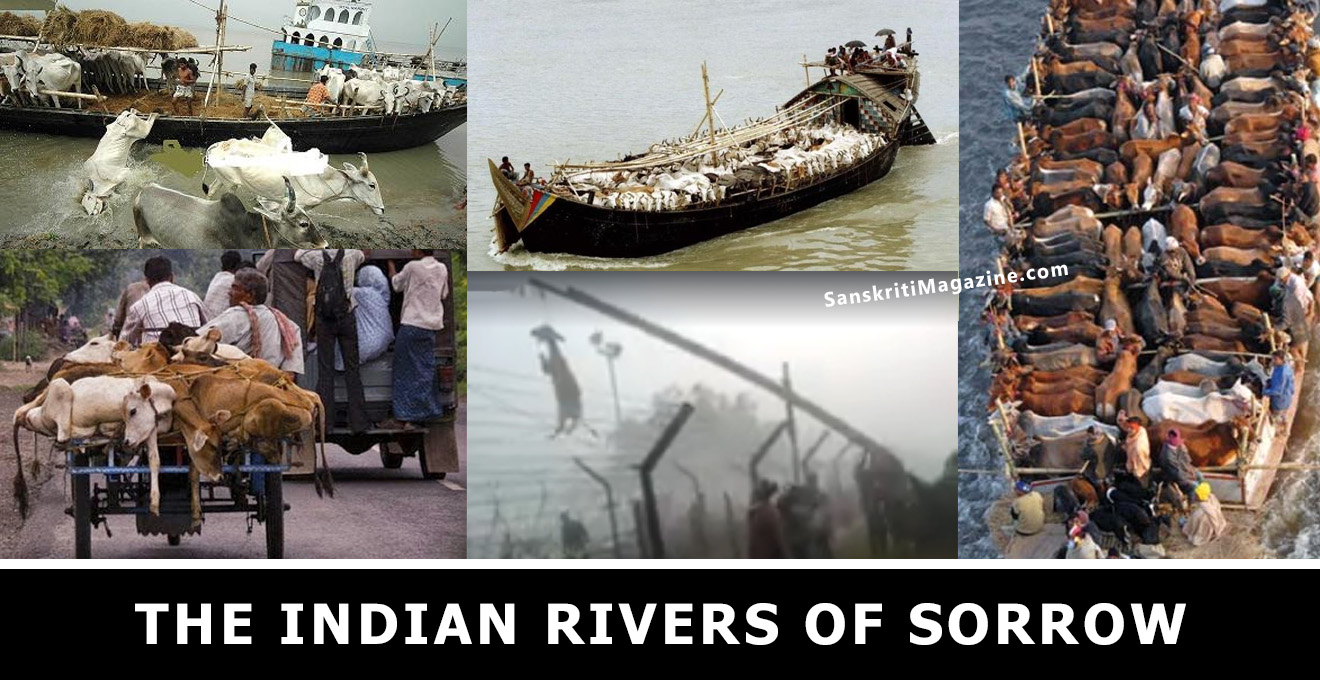A pathbreaking conservation programme in Tamil Nadu’s Valparai plateau shows the way to reducing human-animal conflict, says Rashmi Singh and Rishi Kumar Sharma
Until two to three decades ago, conservation efforts were limited to preserving the forest habitat required by a species and hoping for nature to take care of the rest. This was probably a viable option when human population was low and forests retained their connectivity over vast swathes of land. Wide-ranging species such as elephants could roam from one state to another during their annual migration in search of food and water. However, with the pressures of a rising human population, greater aspirations and demands of a gdp-based economy, this picture of tranquility was to disappear, putting the gentle giants and the poor village folk who happen to share the same habitat into a constant battle of wits for sheer survival.
While cultural tolerance in India towards wildlife is being recognised and appreciated, people living in and on the peripheries of the forests were considered as an impediment to conservation until recently. However, in the past two decades, conservationists had begun to recognise that local communities and their participation in conservation issues was necessary to ensure the success of such programmes in the long run.
Recently, Sir David Attenborough, popular for his BBC Natural History Lifeseries, issued a call urging people to use all possible spaces, including gardens and roadsides, to help wildlife, arguing that protected areas alone are not enough.
 We are incredibly lucky that the people in our country have largely lived peacefully alongside an amazing array of wildlife without grudging the presence of even potentially dangerous carnivores in their backyard. The diversity of the forests is complemented by the diversity of various people who have lived by and off the forests. One only has to delve a little deeper to understand the macro- and micro-level diversity in the human society’s attitudes towards wildlife in different parts of the country. These differences in human attitudes shape the relationship shared by humans and wildlife, while human attitudes themselves are shaped by a range of cultural, socio-economic and traditional factors.
We are incredibly lucky that the people in our country have largely lived peacefully alongside an amazing array of wildlife without grudging the presence of even potentially dangerous carnivores in their backyard. The diversity of the forests is complemented by the diversity of various people who have lived by and off the forests. One only has to delve a little deeper to understand the macro- and micro-level diversity in the human society’s attitudes towards wildlife in different parts of the country. These differences in human attitudes shape the relationship shared by humans and wildlife, while human attitudes themselves are shaped by a range of cultural, socio-economic and traditional factors.
Of all the wild animals, elephants have a special place in Indian culture and mythology. Due to their sheer size, elephants evoke an image of fear and respect, but they are also loved, cherished and worshipped after Ganesha, the benevolent elephant-headed deity. But squeezed hard between the contrasting emotions of reverence and anger over loss of life and livelihoods, the local communities sometimes do retaliate.
On the other hand, the elephants, too, have faced immense hardships, their forests being taken away by mining, their corridors littered with literal death traps in the form of railway lines and consistent stress from constant hounding by farmers and managers of tea and coffee estates.
In a moving story published in The Hindu, TR Shankar Raman of the Nature Conservation Foundation (NCF) describes an encounter with a young tusker, weaving a compelling narrative of how we humans tend to think of ourselves as rational beings, giving little consideration to the intelligence and sentience of other beings. The story ends with an apology to the “gentleman of Iyerpadi”, the young tusker.
However, just as humans who are tolerant towards elephants and other wildlife have limits to their tolerance, so do the wild animals. Pressed hard, they do attack people and sometimes go on a rampage, but it is much easier for us to sympathise with our own species than with an elephant or a tiger.
In the past three generations, the population of Asian elephants has declined by 50 percent and they are now listed as endangered in the International Union for Conservation of Nature red list. Habitat loss by deforestation, landuse change and human encroachments are some of the reasons behind the decline in elephant numbers in India.
Loss of habitat results in shortage of food due to which elephants come near human settlements and raid crops and sometimes attack houses too. These attacks result in conflict with the locals and negative attitudes towards elephants. The conflicts get aggravated when disturbing measures such as bursting crackers, using live trip wires, bullets and crude fire projectiles are used to chase the elephants away.
However, despite all the problems that the poverty-stricken people face, they remain tolerant towards wildlife, including the big and potentially dangerous animals. But what actually determines this tolerance of people towards wildlife? Do education, gender, age and experience influence one’s perception of wild animals? And last but not least, do conservation interventions, including human-wildlife conflict mitigation measures, actually benefit the people? We explored some of these issues during a period of six months of our research in Tamil Nadu’s Valparai plateau, a place known for its manicured tea estates, verdant hills and lush green meadows.
Despite the onslaught of rapid development and rampant destruction of forests, a few places still offer a safe haven to wildlife. One such place is the Valparai plateau, a part of Anamalai hill range. This area is enclosed by the Anamalai Tiger Reserve and surrounded by many other protected areas such as the Parambikulam Tiger Reserve and the Eravikulam National Park.
The Valparai plateau is dominated by commercial plantations, mostly in the form of monocultures of tea and coffee, but is interspersed with about 40 fragments of rainforests that provide habitat to elephants and a myriad other species such as leopards, gaur, spotted deer, sambhar, barking deer, wild boar, Malabar giant squirrel, flying squirrel, brown palm civet, small Indian civet, stripenecked mongoose, birds such as great hornbill, whistling thrush and endemic species such as lion-tailed macaque and Nilgiri tahr.
Raman, a scientist with the NCF, and his team have worked hard to forge partnerships and garner support from several tea estates to restore the tropical rainforests of this region. The basic premise of their conservation effort is that humans have already done so much damage to this biologically rich ecosystem that protection alone cannot ensure the longterm survival of the species that depend upon these forest fragments. Some tea estate managers who have a vision and fondness for wildlife too came forward and became partners in conservation.
The people of Valparai are mostly estate workers who come from the plains in Kerala and Tamil Nadu and go back to their native places after retirement. Local settlements are surrounded by tea estates and forest patches. Living in close proximity with nature, the people share space and time with the local wildlife.
But given the diversity in the human societies, their attitude towards wildlife is shaped by equally diverse histories of different regions, their cultures and past experiences with wildlife. While a community as a whole might have a positive or negative outlook towards wildlife, individuals can have their own, sometimes extreme, positions that can contrast with the overall outlook of the society.
In general, education and awareness are considered as two major factors that influence how people perceive the nature and wildlife around them. It has also been documented that when an administration or bureaucracy is sympathetic towards the suffering of the people living at the interface with wildlife and takes sincere steps to mitigate their problems, people are more tolerant towards cattlekilling predators or crop-raiding herbivores. These considerations form the basis of compensation schemes, livestock insurance programmes, predator-proof pens and interim relief provided by NGOs.
In the past two decades, there has been an escalation in the human-elephant conflict rates in the estates of Valparai. Recognising the difficulties that local people face due to elephants, the team of scientists at NCF started an early warning system comprising bulk message service, cable TV network and red beacon alerts. They found that people were getting killed or injured by elephants mostly when they were caught unawares and an early warning system that would alert people about the presence of elephants would help them avoid unwanted confrontation with elephants.
SMSes are sent to the voluntarily registered numbers and provide information about the location of an elephant herd. News on the local Valparai TV channel can also be seen to get information about the elephant herds with an information crawl about the location of the animals. The red-coloured LED beacons are placed in strategic locations that can be seen by a person returning home from at least a distance of 1 km.
Over the next six months, we interacted with a lot of local people in the tea estates, teashops and homes to find out what they think of wildlife and whether conflict-mitigation measures had helped them.
We found that people believed that human-elephant conflict has escalated due to the shortage of food and water in the forest because of which the elephants are forced to visit human habitations, particularly attracted by their stock of rice and sugar. The people also believed that increased deforestation and disturbance in their habitat have made elephants restless and agitated. Some of the locals have removed banana plants and jackfruit trees around their settlements to discourage elephant visits.
The sheer size of the elephants made people fear for their life and safety and they avoided going out after dark. There have been several human deaths when people accidently bumped into elephants while they were working in an estate or returning home after work. Some of the accidents could have been avoided if the people were more alert or, in some instances, not intoxicated.
Despite all the problems that the people faced, it was unbelievable to see that a large percentage of locals harboured no ill will against elephants and were even sympathetic towards them. For example, one old woman remarked that “we humans have sixth sense and not animals, and hence it is our responsibility to take care of ourselves and our families”. Another middle-aged man said that “if possible, there should be a way in which we humans can get to know that elephants are around and the elephants should not get harmed by that as well”.
In general, the responses from the local people showed that they cared for elephants and felt empathy towards them. During the interviews, many respondents mentioned that most of the accidents happened when the people were unaware of elephant presence and added that the elephants even warn humans to alert them.
 However, a few locals were also unhappy due to the presence of the elephants and thought of them as troublesome animals. Some people suggested that the government should try and curb the elephant population, while others felt that the forest should be fenced to prevent the elephants from coming out.
However, a few locals were also unhappy due to the presence of the elephants and thought of them as troublesome animals. Some people suggested that the government should try and curb the elephant population, while others felt that the forest should be fenced to prevent the elephants from coming out.
The perception of conflict also varied a lot. For some people, only the risk of death and injury was the primary concern, while for others, elephants damaging their flower pots was a major reason of discomfort and negative attitude. A depressing facet of the negative response is the fact that they mostly came from well-educated people.
Among the relatively poor and lesseducated people, those with negative attitudes towards elephants were the ones who had directly or indirectly suffered elephant attacks or been witness to fatal accidents. But even then they did not hold an extreme position that envisioned killing or getting rid of elephants. It was the people who had never been to or dropped out of schools who carried a soft heart for elephants.
All the locals felt that the early warning system was essential and they appreciated the alerts about the presence of elephants. One encouraging trend is that the early warning system is becoming more participatory with more people coming forward to register their cell phone numbers for receiving alerts and also reciprocating by informing the ncf about the presence of elephants in their area so that the others can be informed as well.
Earlier, women were reluctant to share their cell phone numbers, but now they too are coming forward to register their numbers to receive SMS-based alerts. There are also estate workers as well as sensitive company managers who take part in the meetings for conservation of elephants in Valparai, and many of them support the various conservation initiatives undertaken by the NCF.
Human societies are complex and the attitude towards wildlife can never be as simple as it is generally perceived. Education, age, gender, economic status and culture shape one’s attitude, while experiences and individual temperament of the respondent determines a constant shift in attitudes that can range from negative to positive and several conflicting shades in between. Even the perception of loss is so varied ranging from loss being seen as incurred if a house was damaged, while in some instances, loss of a flower pot too invoked a negative reaction and a sense of loss.
For an intelligent and immensely social animal such as the elephant, witnessing the rapid loss of large swathes of forests, death of their family members crushed under speeding trains and the disappearance of their traditional migration routes would have brought in acute suffering. The elephants of Valparai will remain safe as long as there are people who empathise with the immense loss that the elephants have faced and continue to face.
~ Rashmi Singh is a social scientist; Rishi Kumar Sharma is an ecologist at WWF-India











